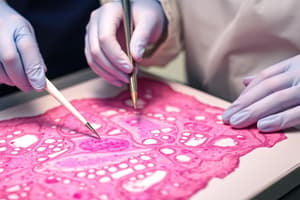Podcast
Questions and Answers
Acetone at 0-4°C is widely used for fixation of tissues intended to study which of the following?
Acetone at 0-4°C is widely used for fixation of tissues intended to study which of the following?
- Lipids
- Carbohydrates
- Proteins
- Enzymes (correct)
Acrolein and chromyl chloride are used at 37°C for 1-2 hours for fixation of tissues intended to study which of the following?
Acrolein and chromyl chloride are used at 37°C for 1-2 hours for fixation of tissues intended to study which of the following?
- Carbohydrates
- Proteins
- Nucleic acids
- Enzymes (correct)
What is absolute alcohol commonly used for in the context of tissue fixation?
What is absolute alcohol commonly used for in the context of tissue fixation?
- Fixation for 24 hours (correct)
- Second fixative after formalin fixation
- Immersing tissues in acetone
- Mordant to tissues
Which technique involves using a mordant for tissues?
Which technique involves using a mordant for tissues?
When is it sometimes useful to submit the tissue to a second fixative after fixation in formalin?
When is it sometimes useful to submit the tissue to a second fixative after fixation in formalin?
Flashcards are hidden until you start studying
Study Notes
Fixatives and Fixation Methods
- Formaldehyde vapour is obtained by heating paraformaldehyde.
- Paraformaldehyde vapour is obtained by heating paraformaldehyde between 50° and 80°C.
- Blocks of tissue require 3-5 hours for fixation, whereas sections require 1⁄2-1 hour.
- Acetaldehyde vapour is obtained by heating at 80°C for 1-4 hours.
- Glutaraldehyde is used as a 50% aqueous solution at 80°C for 2 min to 4 hours.
- Acrolein/chromyl chloride is used at 37°C for 1-2 hours.
- Fixatives include formal saline and cold acetone, which is widely used for fixation of tissues intended to study enzymes, especially when immersing in acetone at a low temperature.
Studying That Suits You
Use AI to generate personalized quizzes and flashcards to suit your learning preferences.




